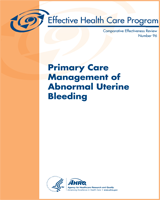NCBI Bookshelf. A service of the National Library of Medicine, National Institutes of Health.
This publication is provided for historical reference only and the information may be out of date.
Structured Abstract
Objective:
The Vanderbilt Evidence-based practice Center systematically reviewed evidence about interventions for symptomatic abnormal uterine bleeding (AUB), both irregular and cyclic. We focused on interventions that are suitable for use in primary care practice including medical, behavioral, and complementary and alternative medicine approaches.
Data sources:
We searched MEDLINE®, CINAHL®, and Embase for randomized controlled trials (RCTs) published in English from January 1980 to June 2012 in women with symptomatic AUB. We also searched regulatory data and scientific publications for data about harms.
Review methods:
Using dual review with a priori criteria, we excluded 1,734 publications because they did not address a Key Question, were not an eligible study design, or did not apply to the primary care treatment of AUB.
Results:
Thirty-nine RCTs (6 good quality, 10 fair quality, and 23 poor quality) evaluated 12 distinct interventions. These included 7 studies of the levonorgestrel-releasing intrauterine system (LNG-IUS), 13 of nonsteroidal anti-inflammatory drugs (NSAIDs), 6 of tranexamic acid (TXA), and 5 of combined oral contraceptive pills (COCs). The majority of studies made direct comparisons to other drugs. Ten studies enrolled women with irregular uterine bleeding; the remainder focused on women with heavy cyclic bleeding. Among women with irregular menses, metformin, metformin with exenatide, and a tricyclic oral contraceptive improved menstrual regularity. Among women with heavy, cyclic menstrual bleeding all seven studies of LNG-IUS favored the intrauterine system in comparisons that included NSAIDs, COCs, progestogens and usual care. Reduction in menstrual blood loss ranged from 70 to 87 percent less bleeding than baseline. NSAIDs reduced bleeding in six of six studies when compared with placebo or progestogens. The degree of improvement was highly variable for individual women. TXA was more effective than progestogens and NSAIDs in three of four studies, and COCs provided benefit compared with placebo in two studies. Harms were rare and trials underpowered to assess harms for all interventions. For most interventions, surveillance studies of longer-term risks were not done in comparable populations.
Conclusions:
Two interventions for irregular bleeding (metformin, COCs) and four for heavy cyclic bleeding (LNG-IUS, NSAIDs, TXA) have low or moderate strength of evidence for effectiveness, while COCs have high strength of evidence. Several common interventions (including diet and exercise and acupuncture) lack sufficient evidence. Across interventions, data are sparse to evaluate long-term improvements and risk of harms.
Limitations include a predominance of small, short trials lacking standard terminology and diagnostic criteria for identifying and including women with AUB. Tools for collecting outcome data are crude (e.g., collection of sanitary products to measure blood loss) and may contribute to a high rate of attrition. Emphasis on biologic outcomes may neglect the importance of patient-reported outcomes that assess whether symptoms are considered resolved by women themselves.
Contents
- Preface
- Acknowledgments
- Key Informants
- Technical Expert Panel
- Peer Reviewers
- Executive Summary
- Introduction
- Methods
- Results
- Discussion
- References
- Abbreviations and Acronyms
- Appendix A Literature Search Strategies
- Appendix B Abstract Review Form (KQ1)
- Appendix C Abstract Review Form (KQ2)
- Appendix D Full-Text Review Form (KQ1)
- Appendix E Full-Text Review Form (KQ2)
- Appendix F Cochrane Risk of Bias Tool
- Appendix G Cochrane Risk of Bias Criteria
- Appendix H Thresholds for Quality Assessment
- Appendix I Risk of Bias and Quality Score for Individual Studies
- Appendix J Evidence Table
- Appendix K Reasons for Exclusion (KQ1)
- Appendix L Reasons for Exclusion (KQ2)
- Appendix M Labeled Indications for Drugs Included in Review
- Appendix N Harms from Package Inserts for Drugs Included in Review
- Appendix O Systematic Reviews
- Appendix P Ongoing Studies
Prepared for: Agency for Healthcare Research and Quality, U.S. Department of Health and Human Services1, Contract No. 290-2007-10065-I. Prepared by: Vanderbilt Evidence-based Practice Center, Nashville, TN
Suggested citation:
Hartmann KE, Jerome RN, Lindegren ML, Potter SA, Shields TC, Surawicz TS, Andrews JC. Primary Care Management of Abnormal Uterine Bleeding. Comparative Effectiveness Review No. 96. (Prepared by the Vanderbilt Evidence-based Practice Center under Contract No. 290-2007-10065 I.) AHRQ Publication No. 13-EHC025-EF. Rockville, MD: Agency for Healthcare Research and Quality. March 2013. www.effectivehealthcare.ahrq.gov/reports/final.cfm.
This report is based on research conducted by the Vanderbilt Evidence-based Practice Center under contract to the Agency for Healthcare Research and Quality (AHRQ), Rockville, MD (Contract No. 290-2007-10065 I). The findings and conclusions in this document are those of the authors, who are responsible for its content, and do not necessarily represent the views of AHRQ. No statement in this report should be construed as an official position of AHRQ or of the U.S. Department of Health and Human Services.
The information in this report is intended to help health care decisionmakers—patients and clinicians, health system leaders, and policymakers, among others—make well informed decisions and thereby improve the quality of health care services. This report is not intended to be a substitute for the application of clinical judgment. Anyone who makes decisions concerning the provision of clinical care should consider this report in the same way as any medical reference and in conjunction with all other pertinent information, i.e., in the context of available resources and circumstances presented by individual patients.
This report may be used, in whole or in part, to inform the development of clinical practice guidelines, other quality enhancement tools, methodologic guidance for systematic review, or to inform reimbursement and coverage policies. AHRQ or U.S. Department of Health and Human Services endorsement of such derivative products may not be stated or implied.
None of the investigators have any affiliations or financial involvement that conflicts with the material presented in this report.
- 1
540 Gaither Road, Rockville, MD 20850; www
.ahrq.gov
